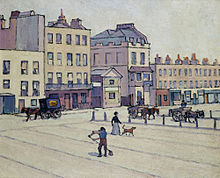
The Cumberland Market Group was a short-lived artistic grouping in early twentieth century London. The group met in the studio of Robert Bevan in Cumberland Market, [1] the old hay and straw market off Albany Street, and held one exhibition. [2]

The Cumberland Market Group was a short-lived artistic grouping in early twentieth century London. The group met in the studio of Robert Bevan in Cumberland Market, [1] the old hay and straw market off Albany Street, and held one exhibition. [2]
Robert Bevan took the rooms on the first floor of 49 Cumberland Market, north of Regent's Park, in April 1914, after the break-up of the Camden Town Group and the formation of its successor, the London Group. He had been a founder member of both organizations. [3] He held meetings there with his friends, and these became a formalised group towards the end of the year, founded by him with fellow Camden Town Group members, Charles Ginner and Harold Gilman, who began to work with the style called Neo-Realism . [2]
They defined what they did as exploring the shapes and colours of daily life (in particular those of north-west London), while also paying attention to their proper disposition compositionally and maintaining sensitivity to the medium of paint itself as key to an expressive image; the strong emphasis on natural observation was a differentiation from the Camden Town Group. [2] [4] These principles were announced in a manifesto by Ginner published in New Age on 1 January 1914, and also employed as the preface to a joint show that year by Gilman and Ginner. It spoke against the "decorative" features of Post-Impressionist followers, as well as attacking academic art. [2]

In 1915 they were joined by John Nash. [2] In April of that year the only exhibition of the Cumberland Market Group was held in the Goupil Gallery. The group was subsequently enlarged by the addition of the American artist Edward McKnight Kauffer [5] and by Christopher Nevinson, but it held no further formal exhibitions. From 1916 to 1917 a School of Painting was run in Soho, based on the group's artistic philosophy. [2] Goupil’s continued to be of help by allowing the group's Saturday afternoon "At Homes" to be moved to their Grey Room. [6] Although not officially dissolved, the group lapsed after Gilman's death in 1919. [2]
In 1921 Bevan organised, with Ginner, an exhibition of Un Groupe de Peintres Anglais Modernes at the Galerie Druet in Paris to present their own work and that of Stanislawa de Karlowska, Gilman, and the next generation artists E.M. O'Rourke Dickey, McKnight Kauffer, John Nash, Edward Wadsworth, William Roberts and Ethelbert White.
A Countryman in Town: Robert Bevan and the Cumberland Market Group was held at Southampton City Art Gallery, 26 September – 14 December 2008. It moved to Abbot Hall Art Gallery, Kendal, 13 January – 21 March 2009. [7]

Vorticism was a London-based modernist art movement formed in 1914 by the writer and artist Wyndham Lewis. The movement was partially inspired by Cubism and was introduced to the public by means of the publication of the Vorticist manifesto in Blast magazine. Familiar forms of representational art were rejected in favour of a geometric style that tended towards a hard-edged abstraction. Lewis proved unable to harness the talents of his disparate group of avant-garde artists; however, for a brief period Vorticism proved to be an exciting intervention and an artistic riposte to Marinetti's Futurism and the post-impressionism of Roger Fry's Omega Workshops.
John Northcote Nash was a British painter of landscapes and still-lives, and a wood engraver and illustrator, particularly of botanic works. He was the younger brother of the artist Paul Nash.

Patrick Heron was a British abstract and figurative artist, critic, writer, and polemicist, who lived in Zennor, Cornwall.

The Camden Town Group was a group of English Post-Impressionist artists founded in 1911 and active until 1913. They gathered frequently at the studio of painter Walter Sickert in the Camden Town area of London.
In art, neorealism refers to a few movements.
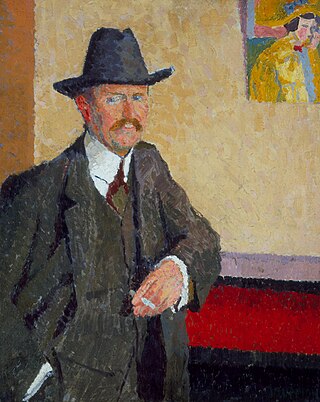
Charles Isaac Ginner was a British painter of landscape and urban subjects. Born in the south of France at Cannes, of British parents, in 1910 he settled in London, where he was an associate of Spencer Gore and Harold Gilman and a key member of the Camden Town Group.
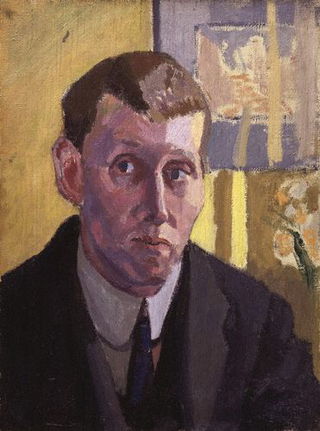
Spencer Frederick Gore was a British painter of landscapes, music-hall scenes and interiors, usually with single figures. He was the first president of the Camden Town Group, and was influenced by the Post-Impressionists.

Francis Vane Phipson Rutter was a British art critic, curator and activist.
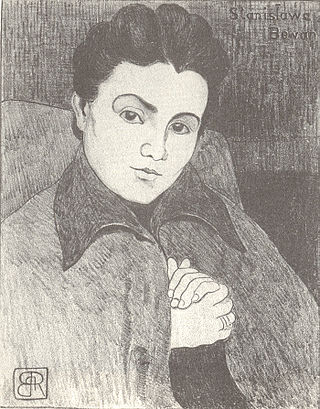
Stanisława de Karłowska was a Polish-born artist who was a founder member of the London Group. Her work combined a modernist style with elements of Polish folk art.
Eric Forbes-Robertson (1865–1935) was a British figure and landscape painter. He was the brother of two actors Sir Johnston Forbes-Robertson and Norman Forbes-Robertson.
Unit One was a British grouping of Modernist artists founded by Paul Nash. The group included painters, sculptors and architects, and was active from 1933 to 1935. It held one exhibition, which began at the Mayor Gallery in Cork Street, London, and then went on an extended tour, closing in Belfast in 1935. The artists planned the group at meetings held at the Mayor Gallery; Paul Nash announced its creation in a letter to The Times on 12 June 1933. A book by Herbert Read, Unit One: the modern movement in English painting, sculpture, and architecture, was published at the time of the exhibition. Despite its brief period of activity, the group is regarded as influential in establishing the pre-eminence of London as a centre of modernist and abstract art and architecture in the mid-1930s.

Harold John Wilde Gilman was a British painter of interiors, portraits and landscapes, and a founder-member of the Camden Town Group.
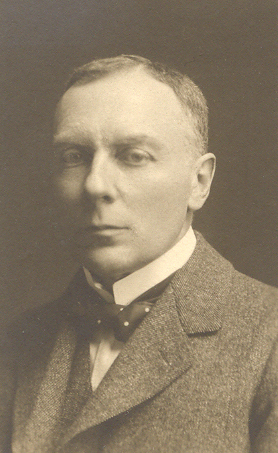
Robert Polhill Bevan was a British painter, draughtsman and lithographer who was married to the Polish-born artist Stanisława de Karłowska. He was a founding member of the Camden Town Group, the London Group, and the Cumberland Market Group.

Edward McKnight Kauffer was an American artist and graphic designer who lived for much of his life in the United Kingdom. He worked mainly in poster art, but was also active as a painter, book illustrator and theatre designer.

Cumberland Market was a London market between Regent's Park and Euston railway station. It was built in the early 19th century and was London's hay and straw market for a hundred years until the late 1920s. An arm of the Regent's Canal was built to the market. The market was surrounded by modest housing, and in the early 20th century became an artistic community. The original houses were demolished during and after World War II and it is now a housing estate, known as Regent's Park Estate.

Robert Alexander Polhill Bevan CBE was a significant figure in British communications and advertising during the mid-20th century. He was the second child of the artists Robert Polhill Bevan and Stanisława de Karłowska and was born at the Bevan house, Horsgate, in Cuckfield, Sussex.
Patrick Baty FRSA is a British historian of architectural paint and colour, who works as a consultant in the decoration of historic buildings.
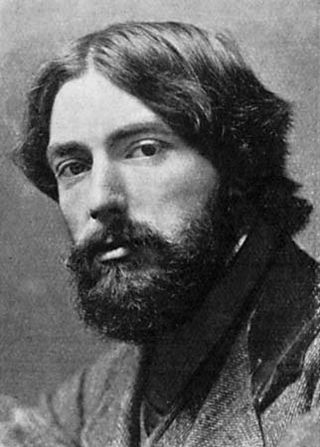
The Crab Tree Club was a nightclub in Greek Street, Soho, London, that was established by the painter Augustus John in April 1914 with the financial support of Thomas Scott-Ellis. John wrote to his friend John Quinn, "We are starting a new club in town called the 'Crab-tree' for artists, poets and musicians... It ought to be amusing and useful at times". The club was a popular meeting place for London bohemians immediately before the First World War who would descend en-masse on the Crab Tree after the Café Royal closed for the night.
William Ian Strang, R.E., was a British draughtsman and etcher who specialised in topographical subjects.
Mary Godwin (1887–1960) was a British oil painter, water colourist and etcher, who often chose landscapes, interiors, and figures as subjects. She studied at the Women’s Department of King’s College with John Byam Shaw, and at Westminster Technical Institute with Walter Sickert and Harold Gilman. She was influenced by the Camden Town Group, and joined its successor, The London Group (LG) in 1914.